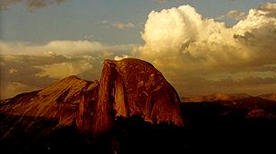|
|
|
|
|
|
If you're not familiar with Yosemite National Park in northern California, click here for a map that will orient you to its location and major features. Close the map window or click on this window to return here. (Source for map: National Park Service Yosemite maps site.)
Our primary object of study in this module will be a contour map of a small portion of Yosemite Park, centering on Tenaya Canyon -- where real hiking (as opposed to our virtual activities) is dangerous and strongly discouraged.
Click here for the contour map. This link opens a new window for the map, and you may switch to that window whenever you need to. The scale of the map depends on the resolution of your screen -- it is marked in the upper left corner. The tick marks on the axes are at approximately 1000 foot intervals in the East-West and North-South directions.
You can locate coordinates for any point on the map by simply clicking on the point -- the coordinates appear at the top of the page just to the right of the map. These coordinates are measured in pixels from the lower left corner of the map, not from the origin of the fixed axes (north shore of Mirror Lake).
In this part of the module, we will concentrate mainly on qualitative features of the map. Serious measurements start in the next part.
 "Half Dome at Sunset", National Park Service Yosemite site |
|
|
|
| modules at math.duke.edu | Copyright CCP and the author(s), 2001-2002 |